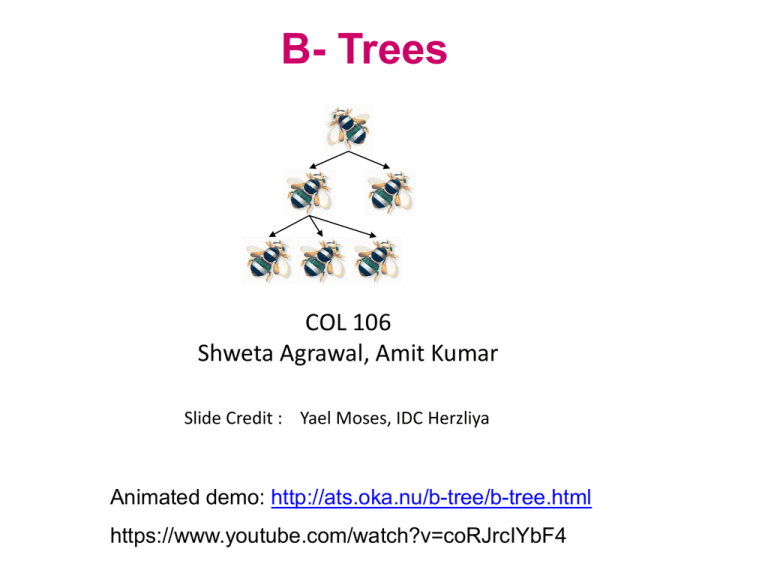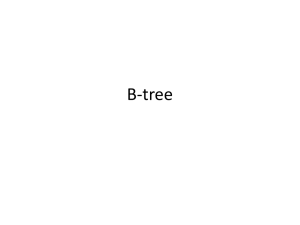B Trees
advertisement

B- Trees COL 106 Shweta Agrawal, Amit Kumar Slide Credit : Yael Moses, IDC Herzliya Animated demo: http://ats.oka.nu/b-tree/b-tree.html https://www.youtube.com/watch?v=coRJrcIYbF4 Motivation • Large differences between time access to disk, cash memory and core memory • Minimize expensive access (e.g., disk access) • B-tree: Dynamic sets that is optimized for disks B-Trees A B-tree is an M-way search tree with two properties : 1. It is perfectly balanced: every leaf node is at the same depth 2. Every internal node other than the root, is at least halffull, i.e. M/2-1 ≤ #keys ≤ M-1 3. Every internal node with k keys has k+1 non-null children For simplicity we consider M even and we use t=M/2: 2.* Every internal node other than the root is at least halffull, i.e. t-1≤ #keys ≤2t-1, t≤ #children ≤2t Example: a 4-way B-tree 20 40 0 5 10 25 35 20 40 45 55 0 5 25 35 45 55 10 B-tree 4-way tree B-tree 1. It is perfectly balanced: every leaf node is at the same depth. 2. Every node, except maybe the root, is at least half-full t-1≤ #keys ≤2t-1 3. Every internal node with k keys has k+1 non-null children B-tree Height Claim: any B-tree with n keys, height h and minimum degree t satisfies: h log t n 1 2 Proof: • The minimum number of KEYS for a tree with height h is obtained when: – The root contains one key – All other nodes contain t-1 keys B-Tree: Insert X 1. As in M-way tree find the leaf node to which X should be added 2. Add X to this node in the appropriate place among the values already there (there are no subtrees to worry about) 3. Number of values in the node after adding the key: – Fewer than 2t-1: done – Equal to 2t: overflowed 4. Fix overflowed node Fix an Overflowed 1. Split the node into three parts, M=2t: – Left: the first t values, become a left child node – Middle: the middle value at position t, goes up to parent – Right: the last t-1 values, become a right child node 2. Continue with the parent: 1. 2. Until no overflow occurs in the parent If the root overflows, split it too, and create a new root node J x … 56 98 …. x … 56 68 98 …. split y 60 65 68 83 86 90 y 60 65 z 83 86 90 Insert example 20 40 0 5 10 15 Insert 3: 0 3 5 10 15 25 35 20 25 35 60 45 55 40 45 M 6; t 3 80 62 66 70 74 78 87 98 60 80 55 62 66 70 74 78 87 98 20 0 3 5 10 15 Insert 61: 40 60 25 35 20 40 45 M 6; t 3 80 55 60 62 66 70 74 78 87 98 80 OVERFLOW 0 3 5 10 15 25 35 20 40 0 3 5 10 15 25 35 45 55 60 45 55 61 62 66 70 74 78 70 80 61 62 66 87 98 SPLIT IT 74 78 87 98 M 6; t 3 Insert 38: 0 3 5 10 15 20 40 25 35 60 45 55 20 40 0 3 5 10 15 25 35 38 70 80 60 45 61 62 66 74 78 87 98 70 80 55 61 62 66 74 78 87 98 M 6; t 3 Insert 4: 20 40 0 3 5 10 15 25 35 38 60 70 80 45 55 20 40 60 61 62 66 74 78 87 98 70 80 OVERFLOW 0 3 4 5 10 15 25 35 38 45 55 61 62 66 SPLIT IT 5 20 40 60 70 80 74 78 87 98 OVERFLOW SPLIT IT 0 3 4 10 15 25 35 38 45 55 61 62 66 74 78 87 98 M 6; t 3 5 20 40 60 70 80 OVERFLOW SPLIT IT 0 3 4 10 15 25 35 38 45 55 61 62 66 74 78 87 98 60 5 0 3 4 10 15 20 40 25 35 38 70 80 45 55 61 62 66 74 78 87 98 Complexity Insert • Inserting a key into a B-tree of height h is done in a single pass down the tree and a single pass up the tree Complexity: O(h) O(logt n) B-Tree: Delete X • Delete as in M-way tree • A problem: – might cause underflow: the number of keys remain in a node < t-1 Recall: The root should have at least 1 value in it, and all other nodes should have at least t-1 values in them M 6; t 3 Underflow Example 60 Delete 87: 5 0 3 4 20 40 10 15 25 35 38 70 80 45 55 61 62 66 74 0 3 4 10 15 20 40 25 35 38 87 98 B-tree UNDERFLOW 60 5 78 70 80 45 55 61 62 66 74 78 98 B-Tree: Delete X • Delete as in M-way tree • A problem: – might cause underflow: the number of keys remain in a node < t-1 • Solution: – make sure a node that is visited has at least t instead of t-1 keys Recall: The root should have at least 1 value in it, and all other nodes should have at least t-1 (at most 2t-1) values in them B-Tree-Delete(x,k) 1st case: k is in x and x is a leaf delete k k=66 x 62 66 70 74 How many keys are left? Example t=3 x 62 70 74 k=50 x 30 50 70 5 y 35 40 45 Example t=3 x 90 6 30 45 70 5 7 y 35 40 45 90 6 7 2nd case cont.: c. Both a and b are not satisfied: y and z have t-1 keys – Merge the two children, y and z – Recursively delete k from the merged cell x y 35 1 2 x 30 50 70 90 40 60 z 55 3 4 5 6 30 y 35 40 50 1 Example t=3 70 2 3 90 55 65 4 5 6 Questions • When does the height of the tree shrink? • Why do we need the number of keys to be at least t and not t-1 when we proceed down in the tree? Copyright © The McGraw-Hill Companies, Inc. Permission required for reproduction or display. Delete Complexity • Basically downward pass: – Most of the keys are in the leaves – one downward pass – When deleting a key in internal node – may have to go one step up to replace the key with its predecessor or successor Complexity O(h) O(logt n) Run Time Analysis of B-Tree Operations • For a B-Tree of order M=2t – #keys in internal node: M-1 – #children of internal node: between M/2 and M – Depth of B-Tree storing n items is O(log M/2 N) • Find run time is: – O(log M) to binary search which branch to take at each node, since M is constant it is O(1). – Total time to find an item is O(h*log M) = O(log n) • Insert & Delete – Similar to find but update a node may take : O(M)=O(1) Note: if M is >32 it worth using binary search at each node A typical B-Tree Copyright © The McGraw-Hill Companies, Inc. Permission required for reproduction or display. Why B-Tree? • B-trees is an implementation of dynamic sets that is optimized for disks – The memory has an hierarchy and there is a tradeoff between size of units/blocks and access time – The goal is to optimize the number of times needed to access an “expensive access time memory” – The size of a node is determined by characteristics of the disk – block size – page size – The number of access is proportional to the tree depth











